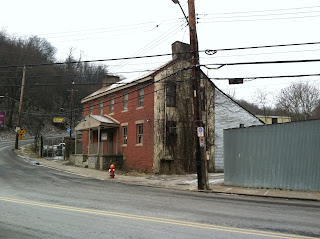It's interesting how Duquesne and Braddock stare at each other across the Monongahela River, like the ancient foes that their namesakes were. (Duquesne was the governor of New France, and Braddock was the British general who was sent to oust French forces from the region.) For years I've dreamed of Braddock. I always imagined that it's the ultimate in urban ghost-towning destinations. The town's utter collapse and subsequent attempts at revival have attracted the attention of everyone from the editors of The New York Times to The Colbert Report. This is the legendary city as seen from across the Mon.
Braddock did not disappoint me, but it did surprise me. I expected bleak expanses of "urban prairie," utter desolation, warehouses, and thickets, and roving packs of feral dogs. But, despite a great many abandoned buildings, the place is not lifeless. Nor is it ugly. It's situated pleasantly on the hillsides above the river. The streets have a nice feng shui to them, too. In its disrepair, you might describe the place as "wabisabi."
It's definitely an old factory town, with lines of identical rowhouses, steep streets, and a weed-choked riverfront. And yet, there's a kind of enduring character to the place. The whole town is built to a human scale. It's walkable, with sidewalks and good proximity. Its public buildings display the lovely architecture that used to keep life rich and mysterious. Not everyone was educated in the Braddock of old, but everyone had easy and equal access to beauty.
And it's not all working class neighborhoods. A few graceful mansions still stand on the heights above the main street, Braddock Avenue. You've actually got three separate municipalities all blurred together in this stretch of the valley: Braddock, North Braddock, and Braddock Hills. I'm not really sure where one begins and the other ends, but they've all got a similar feel. Maybe we should call this general area "The Braddocks" in the same way people refer to "The Hamptons."
Braddock's famous decline has been memorialized by a series of Levi's Jeans ads. In fact, George Romero (of zombie fame) made his least grotesque movie here in Braddock in 1978, and even at that time, the town's decline was a major factor in the story's plot. It's a vampire film called Martin, and in it, the old town is still very recognizable.
Unlike the other half-empty towns of the Monongahela Valley, Braddock is still home to a bustling steel factory. In this town, all roads lead to US Steel's Edgar Thomson plant, the oldest and last surviving steel factory in the region. Of course, the mill employs far fewer steelworkers than it did in former times. And because the jobs pay well, few if any of the workers choose to live in Braddock. All the same, there's a kind of movement here that Duquesne lacks. Trucks go rumbling past. Cars pass along the main drag.
It was probably pretty bad juju to name a city after the ill-fated General Edward Braddock, whose 1755 defeat took place on the town site, at the hands of a much smaller French and Indian army. When the old factory was being built--in the late 1800s--it's said that the workmen discovered many English skeletons still strewn about in the forest. Braddock died of wounds he sustained in battle and is buried south of here. By all accounts, he was an arrogant, inflexible bastard. Most histories report that his disgraceful defeat was the result of his poor treatment of Indian allies and his refusal to respect the opinions of colonials.
The public library in Braddock was the first "Carnegie Library" in America. It's still one of the busiest, most appealing places in town.
Some few streets look relatively typical of urban Southwestern Pennsylvania: densely spaced houses, a little rundown, but nothing worthy of this town's sinister acclaim.
To me, this is the most intriguing house in a most intriguing city. It's an old wooden Victorian mansion on the heights above downtown. The porches are all stacked with debris: old furniture, boxes, lawn tools, machinery, all detritus of bygone years. The yard is enclosed with a fence, and there's a "No Trespassing" sign at one of the gates. Check out the photo below for a glimpse of the trash-laden porches.
Braddock is more compact than Duquesne. It might even feel less destitute than its neighbor across the river, and there's a clear sense of community pride here. Its upper streets and alleys are rich with stories. Old, old stories that will never again be told. I really need to come back here for another, longer visit.
Braddock is more compact than Duquesne. It might even feel less destitute than its neighbor across the river, and there's a clear sense of community pride here. Its upper streets and alleys are rich with stories. Old, old stories that will never again be told. I really need to come back here for another, longer visit.



















































